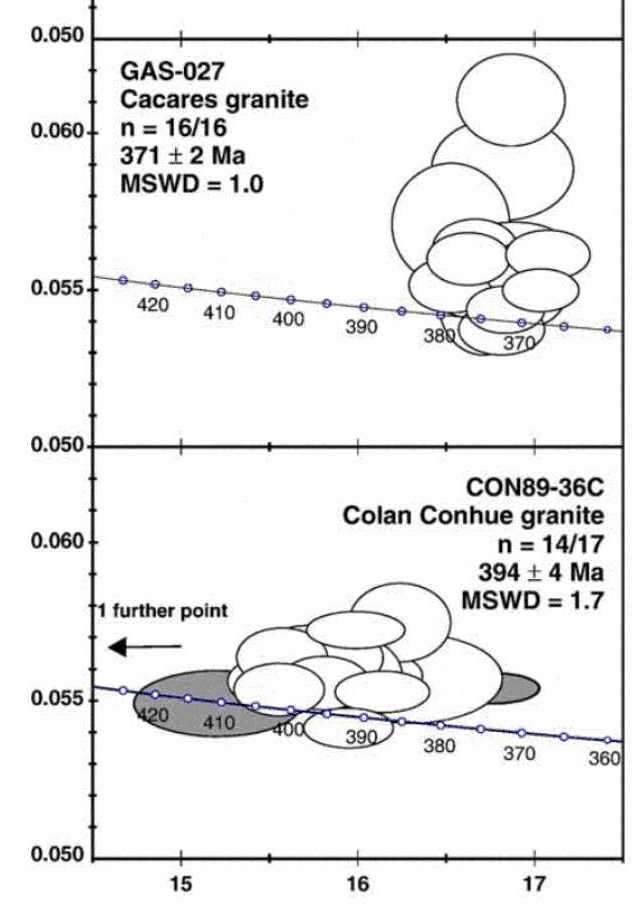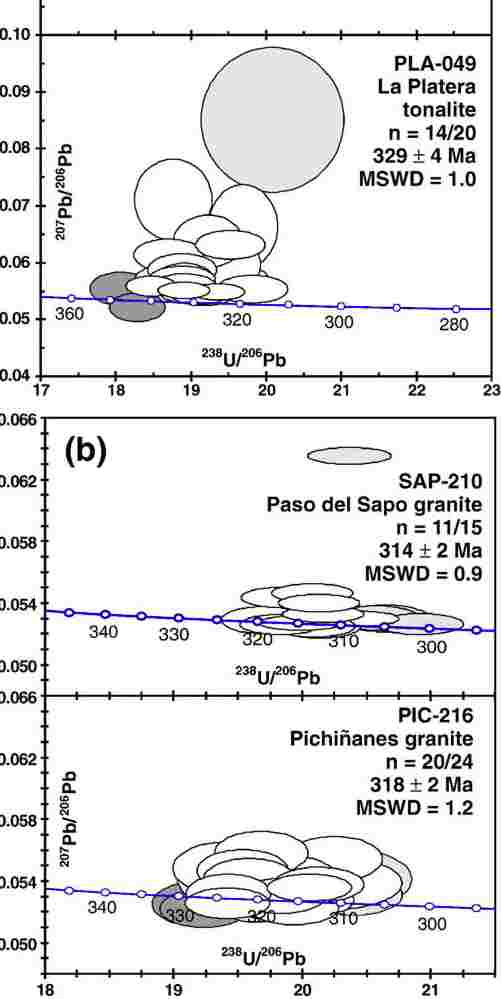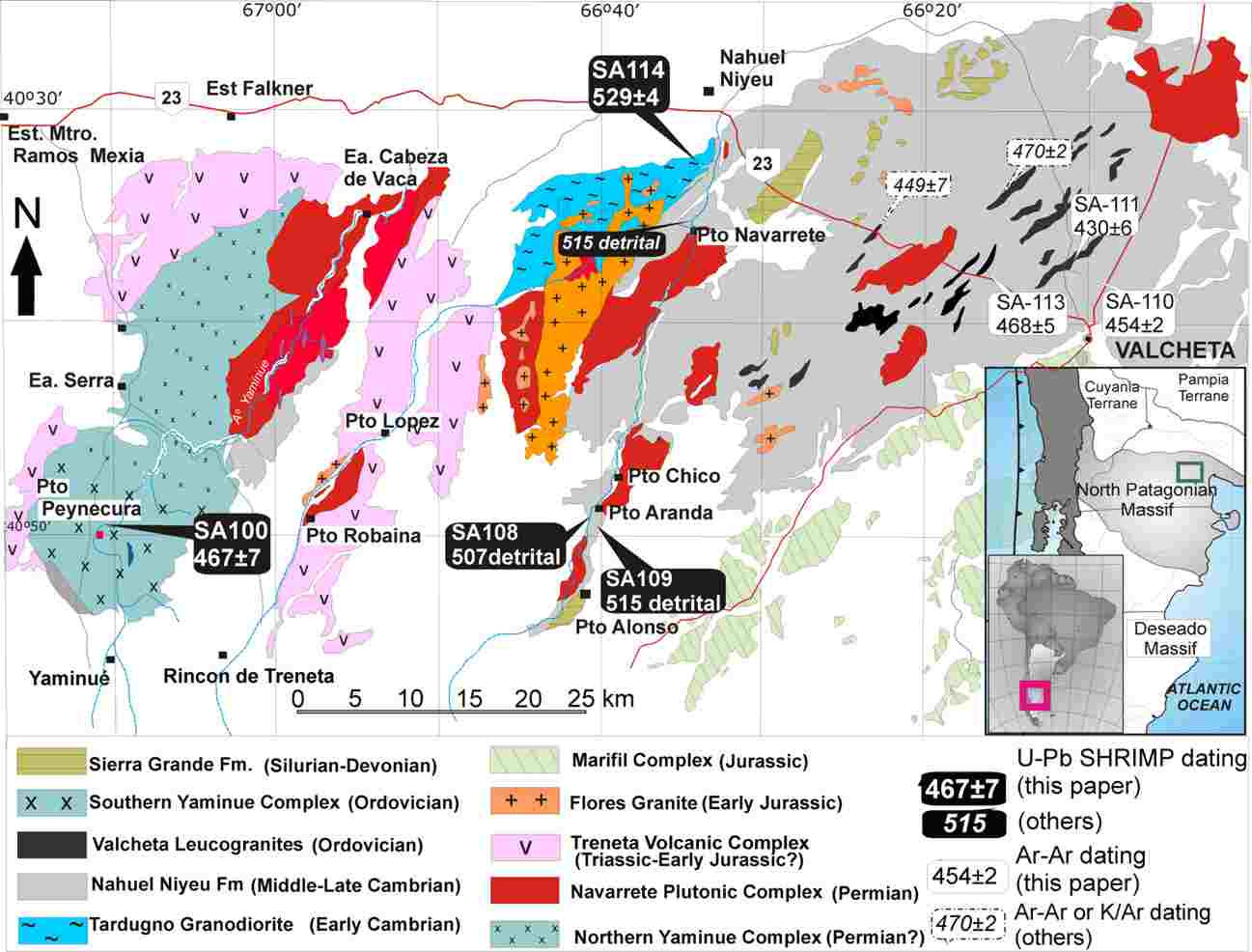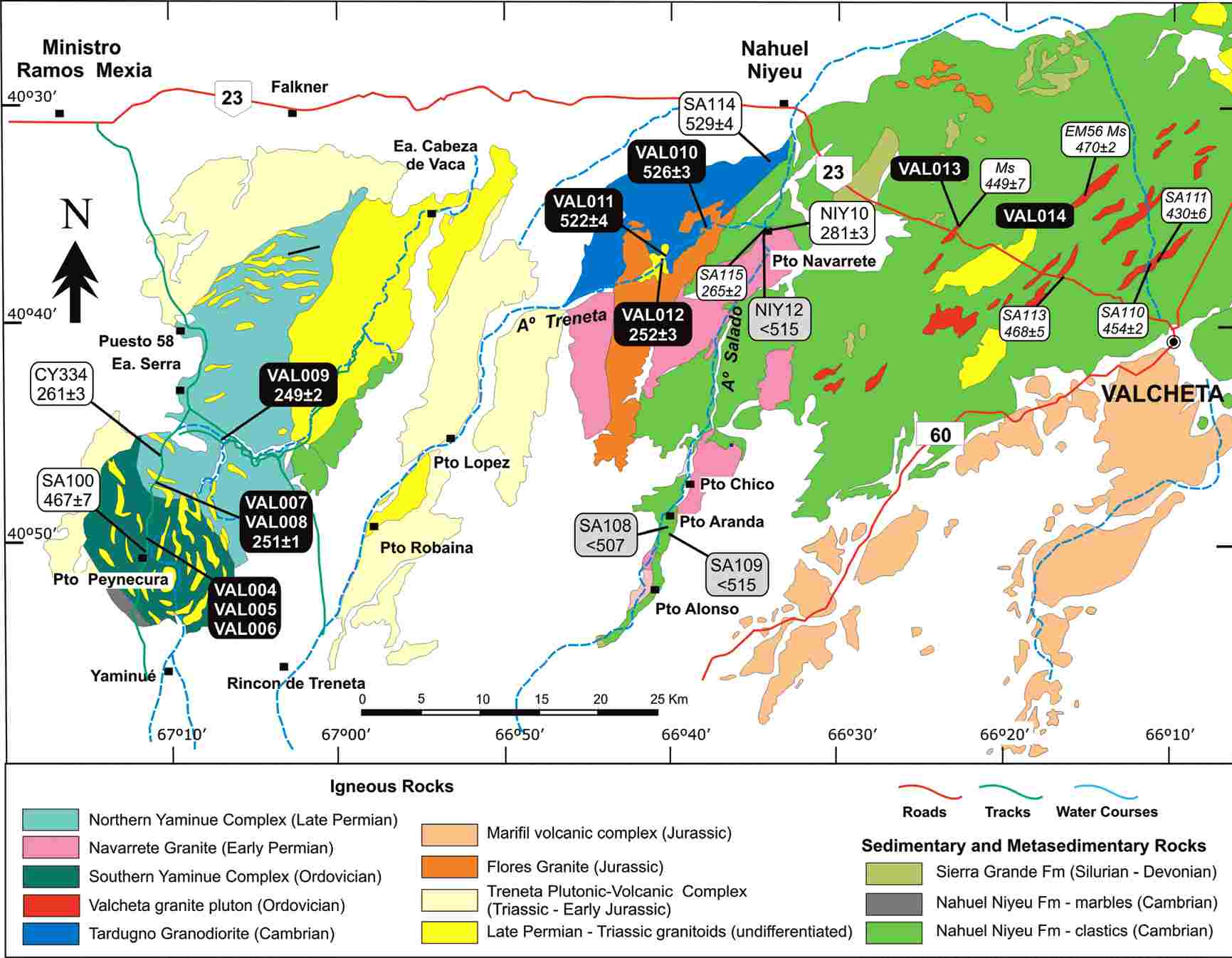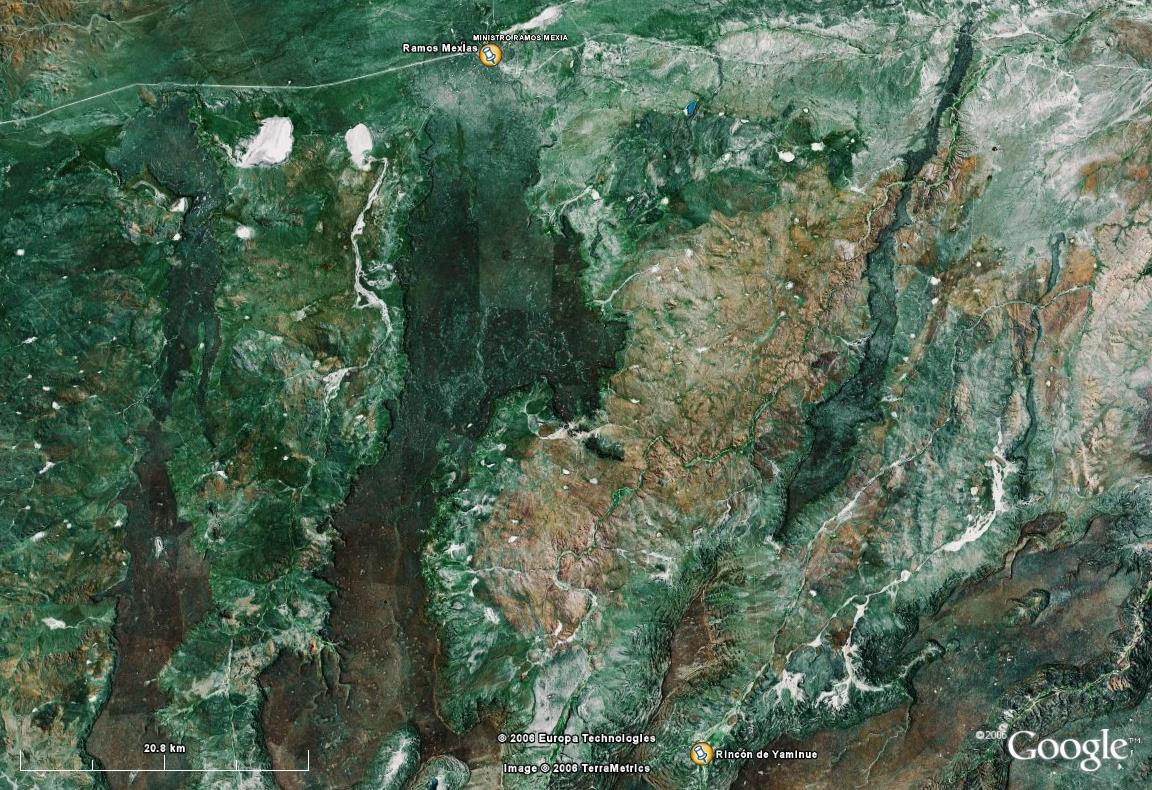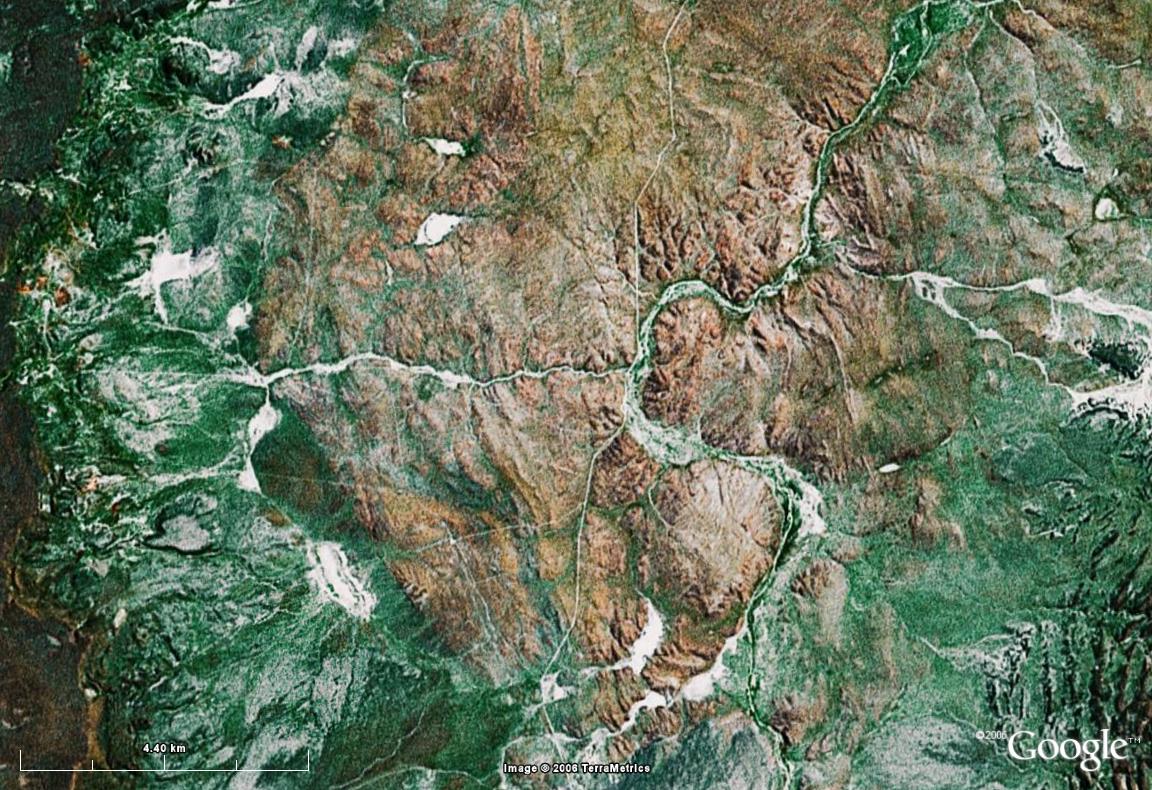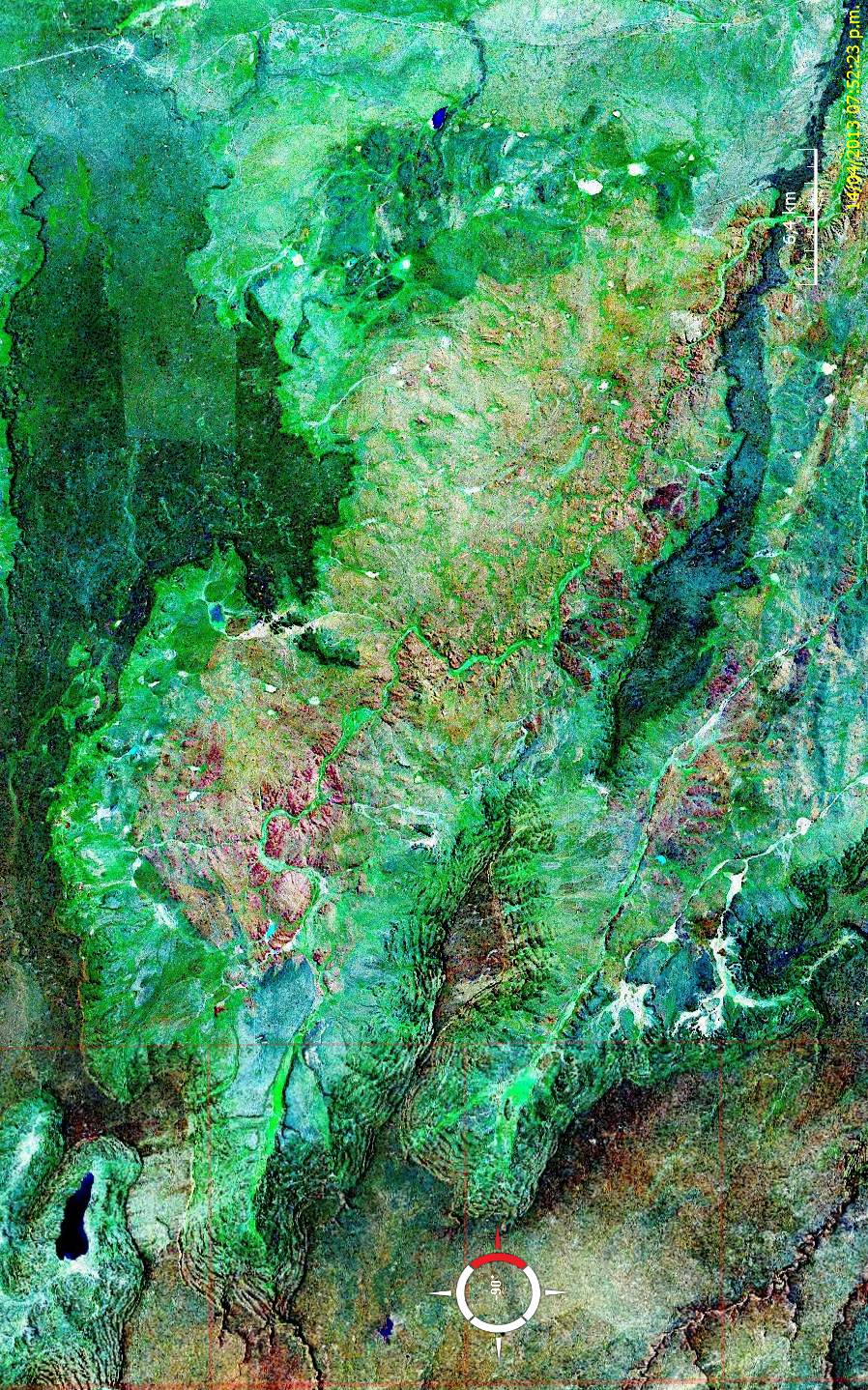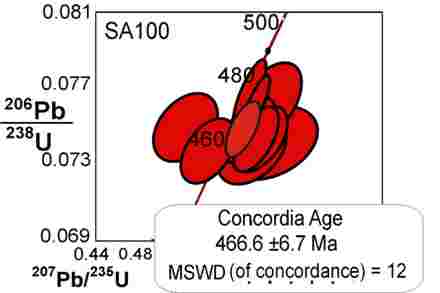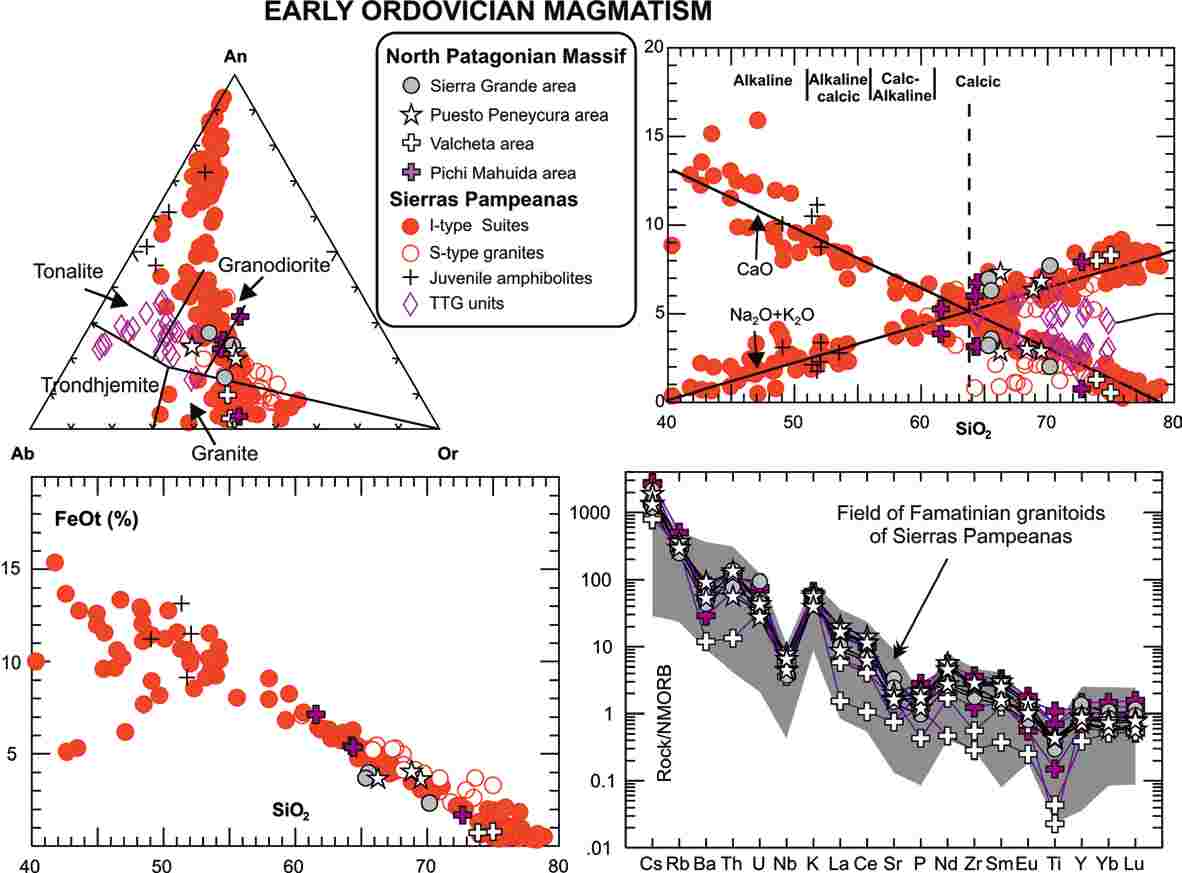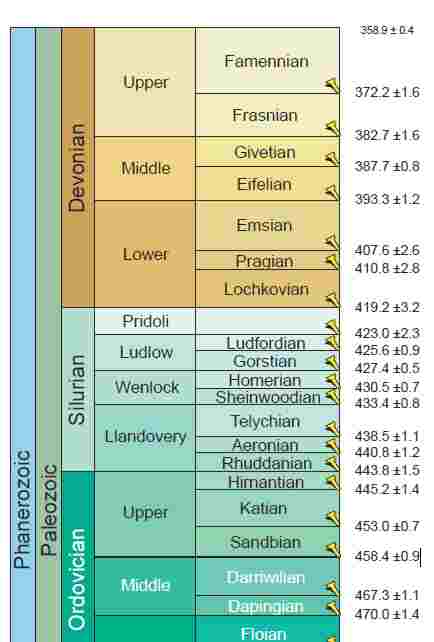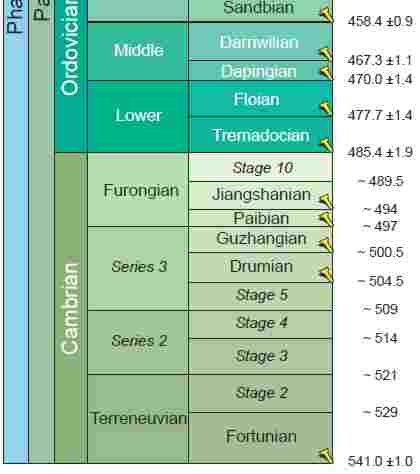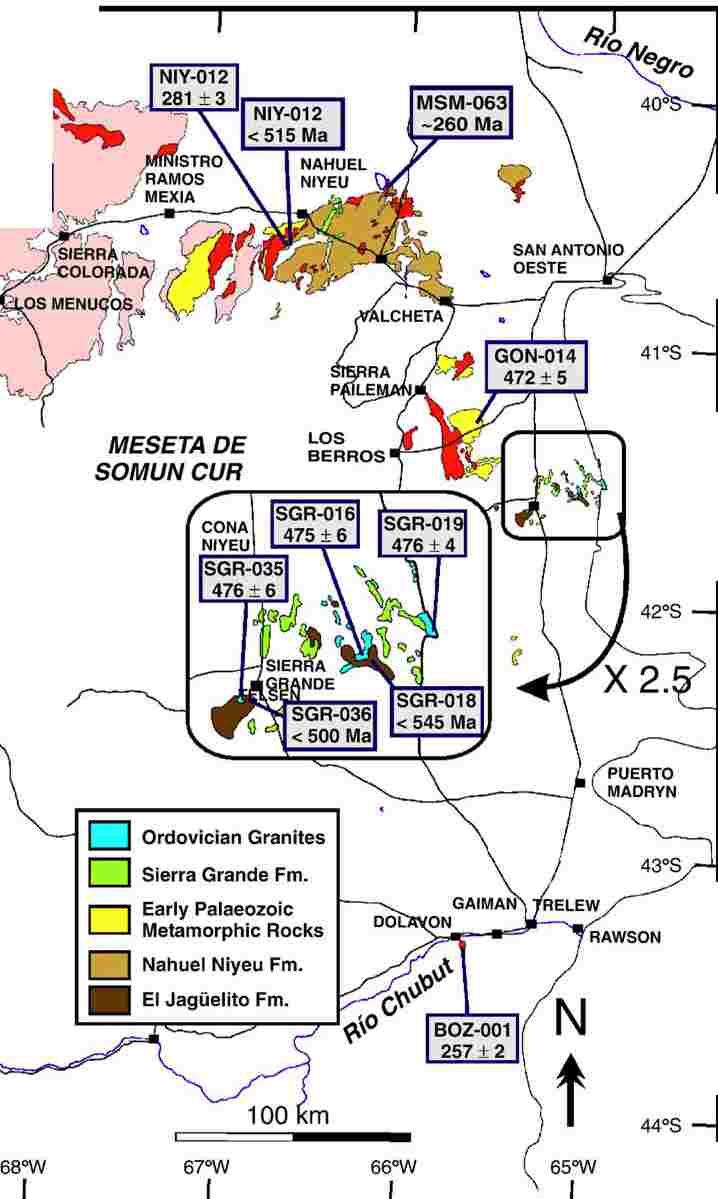SECTOR OCCIDENTAL
Ubicado entre las localidades de Bariloche (Río Negro) y Colán Conhue (Chubut)
Ubicado entre las localidades de Valcheta y Ramos Mexia
SECTOR ORIENTAL
Ubicado entre la localidad de Valcheta y la costa Atlántica
GRANITOS GASTRE, PICHIÑANES, PASO DEL SAPO, LA PLATERA, COLAN CONHUE, CACARES
Edades del Devónico han sido reconocidas en rocas intrusivas ubicadas en el sector occidental de la Comarca Nordpatagónica
Una edad de 371 ± 4 Ma fue obtenida en un granito con megacristales cerca de Gastre en el suroeste del Macizo Patagónico Norte. Para el Granito Colán Conhue ubicado en el centro de Chubut
y 394 ± 4 (recalculado a partir de Pankhurst et al., 2001) para un granito con megacristales similaresen Colán Conhue 300 kilometros al sureste de Bariloche que, como fue sugerido por Varela et al. (2005), puede representarán la extensión de este cinturón.
Complejo Yaminué Sur
El Complejo Yaminué Sur (sensu López de Luchi et al. 2010, and references
therein) occurs near the northern margin of the massif. Exposures in the western area show the better
and larger outcrops and extend from the Yaminué village up to the
south of the Ramos Mexía and Falkner railway stations. The actual shape of the Yaminué Complex
plutons is poorly defined because most of the contacts are covered by
younger volcanic rocks and Quaternary deposits. Largely consists of
foliated equigranular or porphyritic biotite- (locally scarce amphibole)
granitoids together with foliated equigranular biotite–muscovite
leucogranite.
The poorly exposed host rock is a biotite–muscovite schist or gneiss in the northern sector, that can be considered as part of the Nahuel Niyeu Formation, whereas in the southern sector deformed granitoids are in assumed tectonic contact with marbles of unknown age. In the southern sector the deformed magmatic rocks are in apparent tectonic contact with marbles (Chernicoff and Caminos 1996b) of unknown age. To the west the Complex is covered by volcanic facies of the Treneta Plutonic– Volcanic Complex whereas to the east the Yaminué Complex is the country rock of part of the Navarrete Plutonic Complex. Chernicoff and Caminos (1996b) argued for a tectonic contact between the Tardugno Granodiorite and the Nahuel Niyeu Formation in the eastern outcrop region, whereas von Gosen (2003) suggested that the Nahuel Niyeu Formation is the host rock of the Tardugno Granodiorite.
In the western area, the Southern Yaminué Complex forms sheet-like bodies shallowly dipping towards NE of a coarse to medium-grained porphyritic biotite (scarce amphibole) bearing granodiorite–monzogranite, and less frequently of a medium-grained, equigranular to porphyritic biotite–tonalite. Even where lithologies are relatively homogenous, subtle intrusive contacts between sheets can be seen as slight grain size changes from the medium-grained tonalites to the granodiorite–monzogranite. Locally, the leucogranite sheets grade into muscovite bearing pegmatite.
These are separated by sub-concordant sheets of mostly tonalitic biotite orthogneiss, a fine-grained equigranular to porphyritic leucogranite and some pegmatite sills.
In the central part of the complex, less-foliated amphibole–biotite tonalite and granodiorite with mafic microgranular enclaves occur. The porphyritic granitoids are megacrystic (plagioclase in the tonalite and K-feldspar in the granodiorite–monzogranite, both set in a coarse-grained quartz–feldspar matrix). Biotite is the main mafic mineral, with apatite, epidote and opaque minerals as accessories. Deformation, either synmagmatic or solid state while still at high temperature, developed a penetrative planar fabric and parallel high-strain zones, including metre-to-decimetre sheets of mostly tonalitic orthogneiss. Field observations suggest that the porphyritic granodiorite–monzogranite facies probably dominates the middle part of the complex while the tonalite forms most of its base towards the south. Leucogranite sheets are slightly more abundant in connection with the granodiorite–monzogranite or appear as the dominant facies in the area west of Estancia Cabeza de Vaca. This has led us to define a separate leucogranitic unit, i.e. the Cabeza de Vaca granite.
Field observations of the magmatic structures, including the facies contacts and the shape-preferred orientation of feldspar megacrysts, together with the solid-state planar fabric of the Yaminué Complex show a systematic WNW to NW trend. In the northern part, foliation trends mostly WNW with a systematic NE or ENE shallow dip.
However, on the western border of the complex, the fabric is mostly
NNE and shallowly NWdipping. This spatial variation is interpreted as
secondary large scale folding of foliation. In the southern sector, the
NNW-trending planar fabric is also shallowly dipping. The leucogranitic
sheets describe folds with NNW to NW axes in the
southern sector. Lineations measured in the field are subhorizontal to
shallowly plunging to the north or NNE in the northern sector. In the
southern sector most lineations are E–W and shallowly plunging in
both directions. Narrow NNW-trending shear zones are characterized
by intense grain-size reduction and retrogression to greenschist facies
paragenesis.
The porphyritic biotite–tonalite is characterized by scattered
subhedral megacrysts of plagioclase (up to 1 cm) whereas the
porphyritic granodiorite–monzogranite exhibits megacrysts of partly
cross-hatched twinned K-feldspar, up to 3 cmin size, both enclosed in
a coarse-grained matrix of quartz, microcline and plagioclase. Green
or brownish-green biotite is the main mafic mineral. Apatite, epidote
and opaque crystals occur as accessory minerals. Deformation, either
magmatic or solid-state, developed a penetrative planar fabric and
parallel high-strain zones, including meter to decameter-sized sheets
of orthogneisses mostly of tonalitic composition.
Magmatic microstructures are preserved only in lenses surrounded by more intensely deformed rock. In the granodiorite– monzogranite, magmatic microstructures are indicated by the fine straight twins in plagioclase which in some cases develops oscillatory zoning. In the coarse porphyritic granitoids, euhedral to subhedral feldspar phenocrysts are enclosed in an equigranular matrix in which quartz usually occurs as interstitial, anhedral grains. The feldspar megacrysts and the biotite flakes developed a shape-preferred orientation that defines the magmatic foliation and lineation. The quartz grains have moderate undulose extinction with some incipient subgrain boundaries, but with no change in shape or any evidence of recrystallization. Some K-feldspar crystals are internally fractured and infilled with Na-plagioclase.
Chernicoff et al. (2013) described and dated as post-Mississippian the depositional protolith of biotite schist from near Puesto Peynecura in the southern sector, which they considered to be synsedimentary with the marbles.
Edad
Arroyo Yaminué, 600 m north of Puesto Peynecura. VAL004 is a foliated and strongly deformed biotite granodiorite, interlayered with pink leucogranite to pegmatite. Rapalini et al. (2013) obtained a U–Pb SHRIMP zircon age of 467 ± 7 Ma for granodiorite at this locality.
Mapa del sector Ramos Mexía-Valcheta, tomados de Rapalini et al., 2013 y Pankhurst et al., 2014
Imagen del sector de Yaminue. La localidad de Ramos Mexías se observa en el sector NO.
COMPLEJO PLUTONICO PUNTA SIERRA
Inclye el Granito Punta Sierra, el Granito Valcheta, el Plutón Monocchio, Granito Hiparsa, Granito Arroyo Salado.
Cuerpos similares son los Granito Río Colorado y el Granito Curaco, ubicados en Pichi Mahuida, en las cercanías del límite entre La Pampa y Río Negro.
Los afloramientos del Complejo Plutónico Punta Sierra se encuentran sobre la costa atlántica, donde son cubiertos en discor y varios cuerpos pequeños ubicados en la zona oriental y cubiertos mediante discordancia erosiva por sedimentos silúrico-devónicos.
Estos afloramientos, de reducidas dimensiones, conforman la plataforma de abrasión marina en las localidades de Punta Sierra y cercanías de la playa El Salado (De Alba, 1964; Weber, 1983, Busteros et al., 1998).
El afloramiento de Punta Sierra, de unos 5 km2, presenta continuidad hacia el este con el islote Lobos. La roca es un granito con biotita y moscovita e intrusiones de diques graníticos también con moscovita; químicamente corresponden a sienogranitos peraluminosos.
El plutón ubicado en cercanías de la playa El Salado está constituido por una granodiorita con hornblenda y biotita de carácter metaluminoso, que al igual que el caso anterior se encuentra profusamente intruida por diques graníticos (Busteros et al., 1998).
Se incluye tentativamente en esta unidad a un plutón de 10 a 12 km2 que sobre el lecho del arroyo Salado intruye filitas bandeadas de la Formación El Jagüelito. La roca dominante es una granodiorita con biotita y hornblenda con facies tonalíticas, ambas intruidas por diques graníticos y una gran cantidad de enclaves dioríticos.
Las rocas del Complejo Plutónico Punta Sierra son plutones postcinemáticos y discordantes con la Formación El Jagüelito; sus rocas representarían el episodio final en la evolución de los complejos ígneo-metamórficos del sector oriental del Macizo Nordpatagónico.
The Valcheta pluton
The Valcheta pluton is exposed as small, isolated outcrops intruded
into the Nahuel Niyeu Formation for more than 40 km north and
west of the town of Valcheta.
The magmatic association comprises muscovite granites with very fine-grained granite dykes; the former are grey or pinkish, equigranular and allotriomorphic leucogranites composed of quartz (48%), orthoclase–microcline (30%), weakly zoned oligoclase (15%), muscovite (5%), scarce variably chloritized biotite and zircon, apatite and opaque minerals.
Minor amounts of garnet were described by Gozalvez (2009). As
muscovite is a primary magmatic phase, pressure would have
exceeded 3.5 kbar during emplacement. Although no penetrative
planar fabric was observed.
K–Ar and Ar–Ar cooling ages for the Valcheta granites fall in
the interval 470–430 Ma (López de Luchi et al. 2008; Tohver et al.
2008; Gozalvez 2009; Rapalini et al. 2013).
The oldest ages correspond to the more central parts of the pluton whereas the youngest cooling age (430 ± 6 Ma) was obtained from a pink aplo-pegmatitic monzogranite dyke located close to the eastern contact (Rapalini et al. 2013).
The Valcheta pluton may be assumed to be contemporaneous with the Early Ordovician Punta Sierra granites to the SE, although because the only ages refer to cooling it could conceivably be somewhat older.
Las edades publicadas se ubican entre 474 y 476 Ma
Referencias
Busteros, A., Giacosa, R., Lema, H., Zubia, M., 1998. Hoja Geológica 4166-IV Sierra Grande. Provincia de Río Negro. Programa nacional de Cartas Geológicas de la República Argentina 1: 250.000. Segemar, Buenos Aires, Boletín 241. 75 pp
CAGNONI, M.C., LINARES, E., OSTERA, H.A., PÁRICA, C.A. y REMESAL, M.B., 1993. Caracterización geoquímica de los metasedimentos de la Formación Nahuel Niyeu: implicancias sobre su proveniencia y marco tectónico. 12o Congreso Geológico Argentino, 1: 281-288.
CAMINOS, R., 1983. Descripción Geológica de las Hojas 39g, Cerro Tapiluke y 39h, Chipauquil, provincia de Río Negro. Servicio Geológico Nacional (Inédito).
CAMINOS, R., 1996. Descripción Geológica de la Hoja 4166-I, Valcheta, Provincia de Río Negro. Dirección Nacional del Servicio Geológico (inédito).
CAMINOS, R. y LLAMBÍAS, E.J., 1984. El basamento cristalino. En Ramos, V. (Ed.), Geología y Recursos Naturales de la Provincia de Río Negro, 9o Congreso Geológico Argentino, Relatorio, 1 (2): 37-63.
CAMINOS, R., CHERNICOFF, C. J., y RAPELA, R., 1994. Evolución tectónico-metamórfica y edad del Complejo Yaminué, basamento pre-andino nordpatagónico, República Argentina. 7º Congreso Geológico Chileno. Simposio 1: Structural and compo-sitional segmentation of the Andes, Proyecto IGCP No. 345, 2: 1301-1305, Concepción.
Caminos, R., Chernicoff, C.J., Fauqué, L., Franchi, M., Espejo, P., 2001. Geología y
recursos naturales de la Hoja 4166-I, Valcheta, Río Negro. Segemar, Buenos
Aires. Boletín 310, 132.
DALLA SALDA, L. H, CINGOLANI, C. y VARELA, R., 1990a. El basamento de la región occidental del Macizo Norpatagónico, Argentina. 9º Congreso Geológico Argentino, Actas 2: 11-14
DALLA SALDA, L. H., CINGOLANI, C. y VARELA, R., 1990b. The origin of Patagonia. Simposio Proyecto IGCP 279, Terranes of South America. Revista Comunicaciones, 41:55-64 Santiago.
DALLA SALDA, L., CINGOLANI, C. y VARELA, R., 1991a. El basamento preandino ígneo metamórfico de San Martín de los Andes, Neuquén. Revista Asociación Geológica Argentina, 46(3-4): 223-234.
DALLA SALDA, L. H., CINGOLANI, C. y VARELA, R., 1991b. El basamento cristalino de la región norpatagónica de los lagos Gutierrez, Mascardi y Guillelmo, Río Negro. Revista Asociación Geológica Argentina, 46 (3-4): 263-276.
DALLA SALDA, L. H., CINGOLANI, C. y VARELA, R., 1992a. Early Paleozoic orogenic belt of the Andes in southwestern South America: Result of Laurentia-Gondwana collision ?. Geology, 20: 617-620.
DALLA SALDA, L. H., DALZIEL, I., CINGOLANI, C. y VARELA, R., 1992b. Did the Taconic Appalachians continue into South America ?. Geology, 20: 1059-1062.
DALLA SALDA, L. H., VARELA, R. y CINGOLANI, C., 1993. Sobre la colisión de Laurentia-Sudamérica y el Orógeno Famatiniano. 12º Congreso Geológico Argentino, Actas 3: 358-366.
DALLA SALDA, L. H., VARELA, R., CINGOLANI, C. y ARAGÓN, E., 1994. The Río Chico Paleozoic crystalline complex and the evolution of North Patagonia. Journal of South American Earth Sciences, 7 (3-4):377-386.
CHERNICOFF, C.J., 1994. Estructura del basamento cristalino del área Yaminué-Nahuel Niyeu, Macizo Nordpatagónico, Provincia de Río Negro. Tesis Doctoral. Facultad de Ciencias Exactas y Naturales, Universidad de Buenos Aires (Inédito).
CHERNICOFF, C.J. y CAMINOS, R., 1996a. Estructura y metamorfismo del Complejo Yaminué, Macizo Nordpatagónico oriental, Provincia de Río Negro. Revista de la Asociación Geológica Argentina, 51 (2): 3- 10.
CHERNICOFF, C. J. y CAMINOS, R., 1996b. Estructura y relaciones estratigráficas de la Formación Nahuel Niyeu, sector nororiental del Macizo Nordpatagónico, Provincia de Río Negro. Revista de la Asociación Geológica Argentina, 51 (3):3-10.
CROCE, R., 1956. Formaciones características de las estructuras basales de la altiplanicie de Somuncurá en Río Negro. Revista de la Asociación Geológica Argentina, 2 (3): 158-194.
DIGREGORIO, J. y ULIANA, M., 1975. Plano geológico de la provincia del Neuquén, esc. 1:500.000. 2º Congreso Ibero-Americano de Geología Económica, 4: 69-93.
FERUGLIO, E., 1947. Mapa geológico esc. 1:200.000 de la Hoja 40b, San Carlos de Bariloche. Sin texto explicativo. Dirección Minería y Geología.
FERUGLIO, E., 1949. Descripción Geológica de la Patagonia, 1. Dirección General de Yacimientos Petrolíferos Fiscales, Vol. 1, 2, 3; 339 pp., 349 pp., 431 pp.
FRANZESE, J., 1995. El Complejo Piedra Santa (Neuquén): parte de un cinturón metamórfico Neopaleozoico del Gondwana suroccidental. Revista Geológica Chile, 22(2): 193-202.
GALLI, C.A., 1969. Descripción geológica de la hoja 38c, Piedra del Águila, provincias del Neuquén y Río Negro. Dirección Nacional Geología y Minería, Boletín 111:1- 68.
GONZÁLEZ BONORINO, F., 1979. Esquema de la evolución geológica de la Cordillera Norpatagónica. Revista Asociación Geológica Argentina, 3: 184-202. GONZÁLEZ DÍAZ, E. y NULLO, F., 1980. Cordillera Neuquina. Segundo Simposio de Geología Regional Argentina, 2: 1099- 1147.
Gozalvez, M.R. 2009. Petrografía y edad 40Ar/39Ar de leucogranitos peraluminosos al oeste de Valcheta, Macizo Norpatagónico (Río Negro). Revista de la Asociación Geológica Argentina, 64, 183–359.
LEANZA,H.A., 1990. Estratigrafía del Paleozoico y Mesozoico anterior a los Movimientos Intermálmicos en la comarca del cerro Chachil, provincia del Neuquén. Revista Asociación Geológica Argentina, 45(3-4): 272-299.
LINARES, E., CAGNONI, M.C., DO CAMPO, M. y OSTERA, H., 1988. Geochronology of metamorphic and eruptive rocks of southeastern Neuquen and northwestern Rio Negro provinces, Argentina. Journal of South American Earth Sciences, 1: 63-71
LINARES, E., OSTERA, H. y PÁRICA, C., 1990. Edades radimétricas preliminares del basamento cristalino de las vecindades de Mina Gonzalito y de Valcheta, rovincia de Río Negro, República Argentina. 11º Congreso Geológico Argentino, Actas 2: 251- 253.
LIZUAÍN, A., 1983. Descripción Geológica de la Hoja 38 j, Salinas del Gualicho, provincia de Río Negro. Servicio Geológico Nacional, Boletín 195:1-48.
López de Luchi, Mónica G., Augusto E. Rapalini , Renata N. Tomezzoli, 2010. Magnetic fabric and microstructures of Late Paleozoic granitoids from the North Patagonian Massif: Evidence of a collision between Patagonia and Gondwana? Tectonophysics 494 118–137
NULLO,F.E., 1978. Descripci ón geológica de la Hoja 41d, Lipetrén. Servicio Geológico Nacional, Boletín 158:1-88.
NULLO,F.E., 1979. Descripción geológica de la Hoja 39c, Paso Flores. Servicio Geológico Nacional, Boletín 167:1-70.
NÚÑEZ, E., 1983. Descripcón Geológica de la Hoja 38 i, Valcheta, provincia de Río Negro. Servicio Geológico Nacional (Inédito).
NÚÑEZ, E., BACHMANN, E. W. de, RAVAZZOLI, I., BRITOS, A., FRANCHI, M., LIZUAÍN, A. y SEPÚLVEDA, E., 1975. Rasgos geológicos del sector oriental del Macizo Somuncura, provincia de Río Negro, República Argentina. Actas del 2o Congreso Ibero-Americano de Geología Económica, 4: 247-266.
PANKHURST, R., HERVÉ, F. y RAPELA, C., 1994. Sm-Nd evidence for the grenvillian provenance of the metasedimentary basement of southern Chile and west Antarctica. 7º Congreso Geológico Chileno, Actas 2: 1414-1418.
PÁRICA,C.,1986. Resultados geocronológicos preliminares de las Formaciones Colohuincul y Huechulafquen, Neuquén. Revista Asociación Geológica Argentina, 1-2 : 201-205.
Augusto E. Rapalini, Monica Lopez de Luchi, Eric Tohver and Peter A. Cawood, 2013. The South American ancestry of the North Patagonian Massif: geochronological evidence for an autochthonous origin. Terra Nova, 25, 337–342.
RAPELA,C.W., PANKHURST, R.J. y HARRISON, S.M., 1992. Triassic «Gondwana» granites of the Gastre district, North Patagonian Massif. Transactions of the Royal Society of Edinburgh, 83:291-304.
RAVAZZOLI, I.A. y SESANA, F.L., 1977. Descripción geológica de la Hoja 41c-Río Chico. Servicio Geológico Nacional, Boletín 148:1-80.
R. J. Pankhurst, C. W. Rapela, M. G. López De Luchi, A. E. Rapalini, C. M. Fanning & C. Galindo, 2014. The Gondwana connections of northern Patagonia. Journal of the Geological Society, London, Vol. 171, pp. 313–
328. http://dx.doi.org/10.1144/jgs2013-081
SEPÚLVEDA, E., 1983. Descripción Geológica de la Hoja 38 i, Gran Bajo del Gualicho, provincia de Río Negro. Servicio Geológico Nacional, Boletín 194:1-62.
SESANA, F.L., 1974. Contribución al conocimiento de los afloramientos de calizas de Yaminué. 5o Congreso Geológico Argentino, Actas, 2: 293-304.
TOUBES, O. y SPIKERMANN, J., 1973. Algunas edades K/Ar y Rb/Sr de plutonitas de la Cordillera Patagónica entre los paralelos 40º y 44º de L.S. Revista Asociación Geológica Argentina, 27(4): 382-396.
TURNER, J.C., 1965. Estratigrafía de la comarca de Junín de Los Andes (Neuquén). Academia Nacional Ciencias Córdoba, Boletín 44: 5-51.
TURNER, J.C., 1973. Descripción geológica de la Hoja 37 a-b, Junín de los Andes, Neuquén. Servicio Geológico Nacional, Boletín 38:1-88.
VARELA, R., DALLA SALDA, L., CINGOLANI, A. y GÓMEZ, V., 1991. Estructura, petrología y geocronología del basamento de la región del Limay, Provincias de Río Negro y Neuquén, Argentina. Revista Geológica de Chile, 18(2): 147-163.
VARELA,R., TEIXEIRA,W., CINGOLANI, C. y DALLA SALDA, L., 1994. Edad Rubidio-Estroncio de granitoides de Aluminé-Rahue, Cordillera Norpatagónica, Neuquén, Argentina. 7º Congreso Geológico Chileno (Concepción), Actas 2: 1254- 1258.
VATTUONE de PONTI , M.E., 1990: Paragénesis mineral del metamorfismo del área de Aluminé, Cordillera Neuquina. Revista Asociación Geológica Argentina, 45(1- 2): 107-119.
VOLKHEIMER,W., 1964. Estratigrafía de la zona extraandina del Departamento de Cushamen (Chubut) entre los paralelos 42º y 42º 30' y los meridianos 70º y 71º . Revista Asociación Geológica Argentina, 19(2): 85- 107.
VOLKHEIMER,W., 1965. Bosquejo geológico del noroeste del Chubut extraandino (zona Gastre-Gualjaina). Revista Asociación Geológica Argentina, 20(3): 326-350.
VOLKHEIMER, W. y LAGE, J., 1981. Descripción geológica de la Hoja 42c, Cerro Mirador, Chubut. Servicio Geológico Nacional, Boletín 181:1-72.
WICHMANN, R., 1918. Estudios geológicos e hidrogeológicos en la región comprendida entre la boca del río Negro, San Antonio y Choele Choel. Anales del Ministerio de Agricultura de la Nación, Sección Geología, Mineralogía y Minería, 13 (3):1-43.
WICHMANN, R., 1919. Contribución a la geología de la región comprendida entre el río Negro y el arroyo Valcheta. Con una descripción petrográfica de las rocas eruptivas y metamórficas por el Dr. F. Pastore. Anales del Ministerio de Agricultura de la Nación, Sección Geología, 13 (4):1-45.
WICHMANN, R., 1927. Resultados de un viaje de estudios geológicos en los Territoros del Río Negro y del Chubut, efectuado durante los meses de enero hasta julio del año 1923. Dirección General de Minas, Geología e Hidrología, Publicación 33, 59 pp.
WICHMANN, R., 1931. Mapa geológico del Río Negro extraandino. En Groeber, P., 1931, El doctor Ricardo Wichmann y su obra científica. Physis, 10 (36): 264-298.

